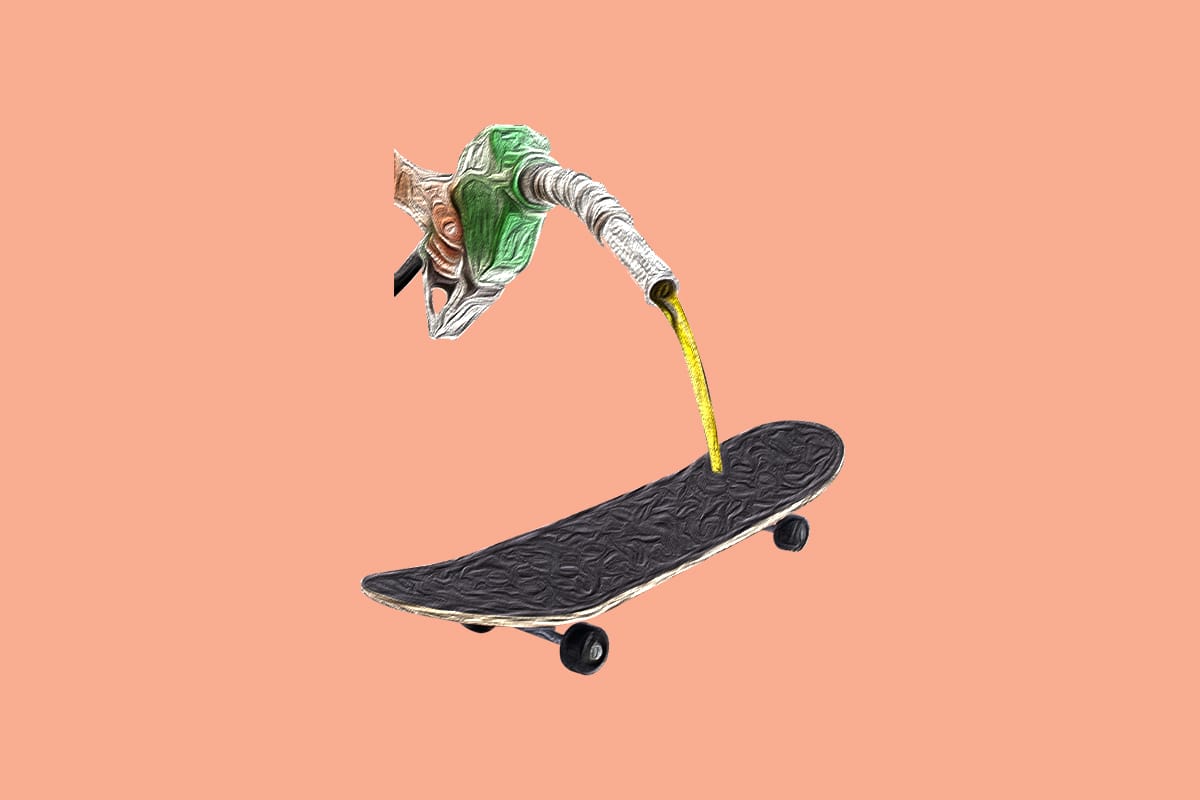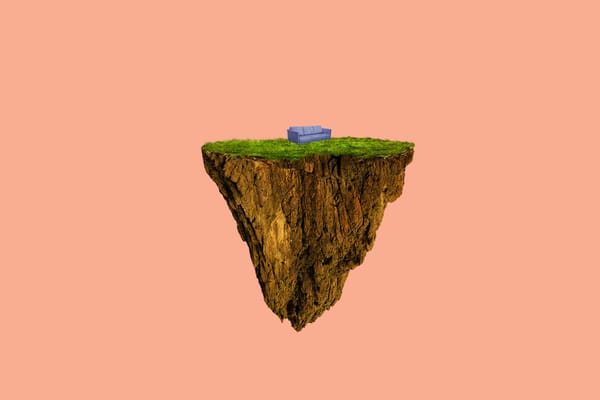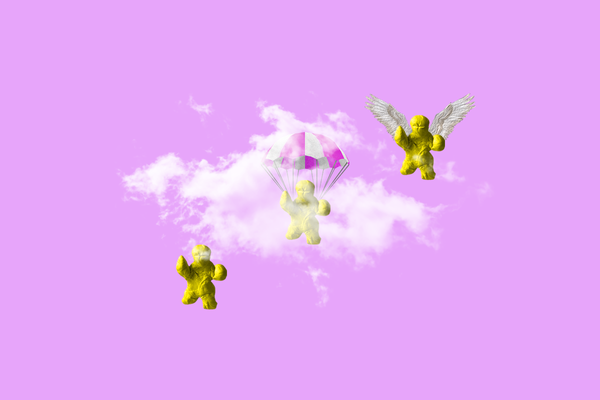Premium unleaded
Plus: SLS gets Power Slapped, Fits of The Kingdom, can you please spare a clip? and more.

The definitive weekly ranking and analysis of all the skateboarding and other online things that I cannot stop consuming and how they make me feel, personally.

Goddamnit, David Mandel, you fool
Rank: 1972
Mood: 🛹 🚧

You call yourself the executive producer and director of Veep, Curb Your Enthusiasm, Seinfeld, and EuroTrip. Yet, you think we live in a world where skatestoppers existed in early 1970s America, where your recent show Whitehouse Plumbers takes place? Are you not an avid reader of the Chicago Tribune? Their former staff writer Dan Mihalopoulos first reported on the creation of skatestoppers in the year of our lord, 2000.
Skateboarders had long been unwelcome outside the office park in Schaumburg, where they chipped concrete ledges, scraped paint from handrails and splintered benches.
"You can chase them away, but an hour later they'll come back. Or they'll do it on the weekend, when nobody is here," complained Fernando Osorio, chief engineer for the One Woodfield Lake complex at 1000 E. Woodfield Rd. It cost $2,000 to replace the damaged benches, he said.
That was before the office park bought 40 Skatestoppers, metal-studded devices that increasing numbers of frustrated property owners are slapping on curbs, handrails and planters to thwart the destructive antics of skateboarders. Since they were installed there last week, the Schaumburg office park has become a no-skate zone.
Chris Loarie, 30, got the idea for Skatestoppers from his brother, a cop in skateboard-scarred Southern California. Loarie invented the product in 1998, and his San Diego-based Intellicept Corp. started national sales through a Batavia distributor in February.
Mandel! You live in Southern California. How could you not notice the “skateboard-scarred” landscape, marred like the aftermath of a summer wildfire, circa 1997, and how that all changed the following year thanks to noted nark Chris Loarie’s invention? Not only is your film set not authentic to the time, but it also shows that you don’t respect the true cultural tastemakers: skateboarders. Do so at your peril.
That said, The Cat In The Hat movie, which you wrote, is pretty underrated. You are forgiven.

Premium unleaded
Rank: 1
Mood: ⛽
Gassed Up, Nike SB’s latest offering, is a fun, well-paced edit that’s also a good reminder of the footwear giant’s roster depth, despite the constant rumblings and rumours of cutbacks and rider contracts not being renewed. While it would be naive to assume that most of the skaters in Gassed Up are getting paid much, if at all, to be in this Nike-produced promotional project, having Nicole Hause, Poe Pinson, Hayley Wilson, Arin Lester, Sky Brown, Sarah Meurle, Chloe Covell, Victoria Ruesga, Funa Nakayama, Elissa Steamer, and more in the same video is certainly a flex of ridership if nothing else.
Beyond that loose analysis and speculation, there is the concrete: the skateboarding in Gassed Up is good as hell. Hause continues to be one of the hardest charging and bailing skateboarders out and is always a treat to watch. Lester’s technical precision is nice to see on the big screen (YouTube) as opposed to her Instagram. Alliterative phenoms Poe Pinson and Chloe Covell are already such forces whose abilities grow by leaps and bounds each time we see them that it’s not a stretch to think that either could be enduring household names in a few years’ time.
Admittedly, I hadn’t followed Hayley Wilson’s skateboarding too closely before Gassed Up. If there was any positive to that glaring oversight, it’s that her show-closing section in the video was an excellent surprise. Speed, power, technicality, and that innate ability to just look cool on a skateboard — Wilson has it all in spades. A great capper on a great video. It always feels a bit weird to shout out to an unfeeling corporate behemoth like Nike, but in this instance, I do gotta hand it to them.

Street League gets Power Slapped around
Rank: Oof
Mood: 👋 🤕

So this is a cool place to have ended up, eh, Street League? Doing cross-promotion on social media for Power Slap and your shared streaming partner, the explicitly right-wing video platform Rumble? I’m sure this is what all of the kids who follow your Instagram account for contest clips of Rayssa Leal and Yuto Horigome are pining to see: some random person getting paid roughly $2,000 to get knocked unconscious with an open-hand slap and no ability to defend themself.
In March, The New York Times talked to one-time Power Slap competitor Kortney Olson.
Taking the strikes, Olson and her opponent, Sheena Bathory, didn’t flinch. That’s not allowed. They did not step back to avoid being hit. That’s not allowed. They did not put their hands up to stop or deflect a beating. That is not allowed, either. When Olson was struck, she lost consciousness, then fell to the stage at the U.F.C. Apex in Las Vegas like a crunched-up soda can tossed away as litter.
“Instantly,” she told me, “it was lights out.”
She got up but immediately fell into a forward roll. She struggled to her feet, wobbly and dazed. “Where am I? What am I doing here?” she recalled thinking.
A slow-motion clip of the blow played on the TBS broadcast [Power Slap’s previous broadcast partnet before getting dropped], her face being disfigured for a television audience of about 415,000 viewers. The camera cut to [UFC president and Power Slap owner Dana White], who watched in a room nearby, gleeful.
Olson, who suffered concussion symptoms in the days that followed, would go on to say that slap fighting should “absolutely not” be sanctioned as a sport. It’s not hard to see why. And if that’s not enough, you have, of all people, Jake Paul in the comments of your Instagram post saying, “This is embarrassing. Don’t poison SLS / skate culture with this.” Street League, if you have me agreeing with Jake Paul, you know you’re doing something wrong. (SLS would later delete Paul’s comment.)
Unfortunately, none of this should be surprising. The new owners of Street League’s parent company, Thrill One Sports & Entertainment, are UFC president Dana White and his Power Slap business partner Lorenzo Fertitta among others. Joe Carr, CEO of Thrill One, is a former UFC exec. In a recent interview with Sports Illustrated, Fertitta said they’d be using the “UFC playbook” to promote and grow skateboarding’s premiere contest.
If you’ve followed the UFC for any period of time, that could mean a number of things, like restrictive contracts that limit athlete freedom and pay to keep them desperate and subservient or the commercialization and commodification of every aspect of the contest that athletes see no cut of. For his part, Fertitta says he and his team were behind SLS’s recent format changes that saw the previously two-day event condensed into a one-day affair, the elimination of women’s prelims, and the introduction of men’s “knockout rounds.”
“We’re creating a bracket so skaters are skating head-to-head to qualify to get into the championship round, which will happen later in the day on Saturday,” says Fertitta. “That allows us to promote some rivalries and give fans the matchups they want to see.”
Cool. While not concussive in nature, much like Fertitta’s other effort in Power Slap, there are glaring flaws. To start, they’ve cut out most of the women’s division from even skating, which seems ignorant at best and cruel at worst (I’ve surmised previously that this may be part of overall cost-cutting measures). Then, the men’s “knockout rounds” now move the winner from each heat to the final, not the highest overall scores from the prelims, which is how it worked previously. That meant in Chicago when most of Ryan Decenzo’s bracket dropped out, he essentially got a free ride to the finals (as a Decenzon mark, I’m not mad about that, but it’s the principle of the thing, c’mon).
What we’ve seen so far — from clunky format changes to toxic new streaming partnerships and cross-promotions — is that trying to transpose the “UFC playbook” onto a skateboarding contest seems incredibly shortsighted. These are vastly different sports. Could it work? Who knows. What does “work” even mean? More profit? If that’s the case, it’s too early to say. But right now, it feels like Street League is just standing helpless at the whim of its new owners, bracing itself for whatever it hits them with next.

Fits of The Kingdom
Rank: 1!
Mood: 🧝♀️ 🧝 🧝♂️
Last week, a dear reader of the newsletter emailed to demand that I cover Link’s pseudo-skateboarding abilities in The Legend of Zelda: Tears of The Kingdom, and I have acquiesced. Unfortunately, I haven’t had time to get too far into the game myself yet — I did build a really long bridge the other day, which was fun — but from what I’ve seen online, Link can skate. Sort of. He doesn’t get to use Ventures or make custom griptape art or anything fun like that, but he can jump onto his shield and grind down rails, which I’m pretty sure is something Vin Diesel does in xXx.
I also came across a video of someone using the Ultrahand and Recall abilities to get Link to do an approximation of a kickflip and a frontside 360 shove-it on a piece of wood outfitted with wagon wheels. That’s cool, even if it seems like a laborious effort to build a cart, press more than four buttons, and perfect the timing just to do a single trick—kind of like learning how to play Skater XL. Sometimes you want the fun to be immediate, you know?
That said, if there is one way Link is relatable to skateboarders outside of trying to MacGyver him into skateboarding, it’s that he’s all about the fits. That forest elf can dress. From his classic green tunic and white leggings (an analogue to the skateboarder’s white shirt and brown Dickies) to magical masks, plate armour — whatever it is, he can pull it off. That’s a skill most skaters appreciate and strive for, and like Link, a good fit is one we’d risk it all for.


Clip me, oh lord
Rank: Mmm… 3
Mood: 😓 😐 😌
Sure, skateboarding can teach you a lot of things. The simple act of doing it teases out new levels of determination, courage, and self-esteem within yourself that you might not have realized existed. One of the more hoary byproducts of riding a skateboard is that it teaches you to get back up. To try again. Because skateboarding demands that you fall. Blood, bruises, and stretched ligaments are the tokens required to access the lesson plan. It’s a never-ending syllabus of pain.
Earlier this week, a friend and I went out skateboarding with the intention of filming, i.e. getting clipped up, harvesting footy, flipping the calendar to Cliptober, etc. We warmed up at a local skatepark, both of us finding our grooves quickly. Then we headed out into the streets. Across four different spots, we got skunked at all of them. Those unforgiving streets were merciless in their rebuke. Chipped and broken boards, ripped pants, and reopened shin scabs were all we got in return for our efforts.
What did I learn from this? Nothing. All that extended failure provided was another thin layer of numbness — that same decades-old scar tissue building on itself, hardening against defeat. In the long run, having such a hardy defence in a world as harsh and cruel as ours is probably a good thing, but I just want some clips, man — even one. Clip me, please. Just a dollop. Sir?

Something to consider: People always tell you to go faster if you’re struggling to land a trick. Next time, try to go Doug.

A good thing: I often write about squirrels here in the “grabbag” section of the newsletter. This is why. What beautiful, brave, compelling creatures. Go forth, young rodent, go.
A good pitch:

Until next week… while time for us is finite, it is ultimately an endless resource. Remember to take some for yourself now and again.


I wrote a book about the history and cultural impact of Tony Hawk’s Pro Skater. Then I made this trailer for it. You can pre-order Right, Down + Circle now from your favourite local bookshop or my publisher ECW Press. I think you might like it.





